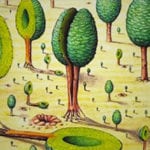 Music
Music  Music
Music  History
History 10 Less Than Jolly Events That Occurred on December 25
 Weird Stuff
Weird Stuff 10 Funny Ways That Researchers Overthink Christmas
 Politics
Politics 10 Political Scandals That Sent Crowds Into the Streets
 Weird Stuff
Weird Stuff Ten Bizarre Facts About The Doge Meme
 Our World
Our World 10 Ways Your Christmas Tree Is More Lit Than You Think
 Movies and TV
Movies and TV The 10 Coolest Stars to Set Sail on The Love Boat
 History
History 10 Things You Didn’t Know About the American National Anthem
 Technology
Technology Top 10 Everyday Tech Buzzwords That Hide a Darker Past
 Humans
Humans 10 Everyday Human Behaviors That Are Actually Survival Instincts
 Music
Music 10 Surprising Origin Stories of Your Favorite Holiday Songs
 History
History 10 Less Than Jolly Events That Occurred on December 25
 Weird Stuff
Weird Stuff 10 Funny Ways That Researchers Overthink Christmas
Who's Behind Listverse?

Jamie Frater
Head Editor
Jamie founded Listverse due to an insatiable desire to share fascinating, obscure, and bizarre facts. He has been a guest speaker on numerous national radio and television stations and is a five time published author.
More About Us Politics
Politics 10 Political Scandals That Sent Crowds Into the Streets
 Weird Stuff
Weird Stuff Ten Bizarre Facts About The Doge Meme
 Our World
Our World 10 Ways Your Christmas Tree Is More Lit Than You Think
 Movies and TV
Movies and TV The 10 Coolest Stars to Set Sail on The Love Boat
 History
History 10 Things You Didn’t Know About the American National Anthem
 Technology
Technology Top 10 Everyday Tech Buzzwords That Hide a Darker Past
 Humans
Humans 10 Everyday Human Behaviors That Are Actually Survival Instincts
Top 10 Fairytales Whose Morals We Could Use Today
Once upon a time, there was a society that could take a lesson or two (or ten) from classic, often anthropomorphic fables. That time was now, and that society was… well, pretty much all of us.
Here are ten takeaways for modern-day humans, borrowed from lackadaisical pigs, sensationalist chickens and, of course, big bad wolves.
Top 10 Gruesome Fairy Tale Origins
10 Three Little Pigs
The Plot: A trifecta of swine each build new homes. The first used straw, the second sticks, and the third bricks. Enter the big, bad, and apparently not halal wolf, who makes short respiratory work of the straw and stick structures. Both pigs flee to the less puffdown-able brick building. The wolf attempts a chimney-entry home invasion, but lands in boiled water and perishes.
The Lesson: So, obviously, straws and sticks aren’t recommended building materials, especially for creatures that far down the food chain. The pig that took the effort to construct a more conventional brick-based dwelling was in the best position to survive life’s inevitable challenges, up to and including carnivores.
Modern-day Application: The bricklaying pig wasn’t just more prepared than his swine brethren, but also a large swath of humanity. Blessed with superior minds and more nimble (and less appetizing) bodies, too many homo sapiens don’t nurture either.
Exercise? Proper nutrition? Reading something longer than a Tweet? Those things take EFFORT. And like a sturdily-constructed home, self-care – the only thing any of us truly controls – pays dividends when life’s obstacles arrive.
Do we really think it’s a coincidence that the COVID-19 death tolls are 10 times higher in countries with obesity epidemics?[1] We eat more slop than pigs… than expect to weather a global health crisis without getting blown to ashes. Even swine know better (well, one in three do anyway).
9 Little Red Riding Hood
The plot: In another big, bad, home-invading wolf-based classic, a young girl traverses both river and woods en route to her grandmother’s abode. Despite promising her mother she wouldn’t talk to strangers, the loose-lipped lass not only chats up a predatory animal but divulges her destination.
Depending on the version, the wolf heads to grandma’s and either eats her or locks her in a closet. The cross-dressing critter then disguises himself as an elderly, female human so convincingly that the lady’s own granddaughter – who is either severely visually impaired or even more severely learning disabled – buys it hook, line and sinker. Only a woodsman, hearing the girl’s screams when the wolf comes clean with his culinary intentions, saves the girl from being dessert.
The Lesson: Don’t be so blindly trusting that the world eats you (or your grandmother) alive.
Modern-day Application: Where do we begin? With the fools on the left who don’t realize news networks like CNN outright lie or turn molehills into mountains – typically by blowing something some conservative said wildly out of proportion[2] – simply to keep them watching and boost their own ratings? Or the fools on the right, who seriously believe that, despite all evidence to the contrary, their preferred candidate won the last election?
Far too few people have effective bullshit detectors these days. The inability to recognize ulterior motives – the wolves in grandma’s clothing – is a key reason for the polarization of western society, and America’s in particular.
8 The Boy Who Cried Wolf
Th Plot: Tasked with tending to a flock of sheep near his quaint village, a shepherd boy decides to have a little fun with the townsfolk. “Wolf! Wolf!” he cries out, name-dropping fairytales’ favorite type-cast villain. Neighbors rush to the wolf-free scene, where the boy laughs at them. He then pulls this shit like three more times.
Enter the Wolf, whose ears were likely ringing by now. With no boiling water or armed woodsmen in sight, he proceeds to scarf down a sheep or two or three. “Wolf! Wolf!” the boy cries. In true “fool me five times shame on us” fashion, no one heeds his call this time around. Not even the powerful Shepherd’s Union could save the lad’s job.
The Lesson: No one believes a liar, even when he speaks the truth.
Modern-day Application: While the previous entry, Little Red Riding Hood, deals with gullibility, the moral of this tale involves its opposite: a widespread societal cynicism resulting from decades of being lied to by officials in various capacities.
Liberals and conservatives, politicians and journalists, corporate executives and union leaders – all habitual liars, and all pushing the public toward a great big shrug that says “they’re all dishonest, so f*ck ‘em”.[3] The result is a tuned-out inability to discern truth from lies even in clear, black-and-white scenarios – a false equivocation born of years of lies and letdowns.
7 Jack and the Bean Stalk
The Plot: A poor young man trades his cow for magic beans, a decision that leaves little doubt as to why he’s destitute. His mom promptly throws them out the window, and likely conducts a thorough drugs sweep of Jack’s bedroom. But the next morning, Jack wakes up to a giant stalk stretching to the heavens. Up he goes, because it’s not like he has a job to get to or anything.
Jack reaches a cloud, whose sole denizen is a giant with gold coins. Jack goes full felon and steals them. The next day, he returns for a goose that lays magic eggs. Despite now having a sustainable source of precious metal, Jack returns to pilfer a gold harp. But the harp makes noise, and the giant gives chase. Jack reaches the bottom and chops down the stalk, killing the giant in an ending few would describe as fair.
The Lesson: Officially, the moral involves taking advantage of life’s opportunities.[4] But considering Jack was a thief who wasn’t satisfied after literally robbing a living gold manufacturing facility, “don’t be greedy” comes to mind.
Modern-day Application: Top to bottom, society is obsessed with more-ism. From corporations who place short-term shareholder profits over responsible corporate citizenry, to regular folks who think their next purchase will be the ticket to happiness, too much never seems to be enough. Accumulating wealth while depreciating personal values is a path to moral bankruptcy.
6 The Ugly Duckling
The Plot: A duckling is hatched that is totally the Billy of the Baldwins: weird-looking, misshapen and comparatively unattractive. Even the duckling’s mother refuses to admit she made something so ugly; if such behavior is normal, Colin Hanks is one lucky guy.
Anyway the duckling runs away and, at first, the world concurs. A mean old lady and some incel loser call the baby bird hideous. But a kind farmer takes the duckling home to ride out the winter months. When the duckling returns to the pond, its reflection in the water shows a beautiful swan. In my version, the swan then murders its mother and siblings, but that’s probably not what happened.
The Lesson: Judging someone by their differences is not only unfair but often shortsighted.
Modern-day Application: Expelling someone from the flock for their differences? Sounds like cancel culture to me. Physically attractive or not, people do ugly things – they make mistakes, have false assumptions, act unwisely. The lack of forgiveness and tolerance in modern society is unhealthy and, unfortunately, yet another downward trend exacerbated by social media.
Furthermore, tribalism is inherently ugly. On the left, this means excluding people from “progressive” identity politics solely because their sex, skin color or sexual orientation makes it impossible to completely empathize. And on the right is seen a similar ugliness: scapegoating of minorities, with the rise in COVID-centric violence against Asian-Americans[5] the latest example.
5 Chicken Little
The Plot: A foolhardy fowl gets bonked on the head when a clumsy squirrel drops an acorn. The projectile rolls out of sight, leaving the concussed chicken clueless regarding his headache’s source.
So the diminutive chicken, who apparently watches a lot of cable news, decides the sky is falling. He converts several cohorts into co-conspirators, and they take their case to the King. Unconvinced of the sky’s pending collapse, His Highness leads the de facto jury back to the scene of the crime. When the squirrel shows up inquiring about his missing nut, the matter is solved to everyone’s satisfaction.
The Lesson: Catastrophizing every little bump in the road – or on the head – is alarmist and silly.
Modern-day Application: Obviously, a wide array of media sources blow things wildly out of proportion, or stretch reasonably important stories into weeks-long, all-consuming ones. CNN creating a fake cockpit[6] during monthlong, round-the-clock coverage of a missing airplane comes to mind.
Equally ridiculous is the clownish catastrophizing in which everyday citizens engage – especially on social media. Blessed with a bullhorn, blowhards far and wide make world-ending crises out of their tunnel-vision projects and pet peeves, competing for Best Online Dramatic Performance against a countless thread of other exaggerators. My favorite is when a D-list celebrity dies and half the Internet goes full-scale cyber coffin-jumper, acting like Gandhi just got crucified in a shameless way to draw attention to themselves.
4 The Emperor’s New Clothes
The plot: A fashion-conscious emperor was a walking “Who Wore It Better?” meme. Seeing his weakness – self-obsessed vanity – two thieves sold him on commissioning his grandest garb yet. The new outfit, they claimed, would be so fine only smart folks could see it, while common fools saw nothing at all.
Soon, the king’s men stopped in for a status report. They saw the thieves cutting thin air with scissors but, to protect their royal rep, told the emperor the suit was coming along just fine, thanks. When the faux-everything fabrics were complete, the emperor, too, acted as if. He pranced about town in his new suit – his birthday suit, to be exact. Townsfolk dared not address the exposed royal jewels until a young child, untainted by a society buttressed by bullshit, finally revealed the naked truth.
The Lesson: Don’t let fear of public rebuke keep you from stating a plain truth.
Modern-Day Application: Two words: Runaway Wokeness. The hesitance – especially of reasonable centrists and liberals – to denounce the eyeroll-inducing virtue signaling and purity tests of the extreme left has led to cancel culture, identity-first selfishness and idiotic notions like defunding law enforcement.
To quote (US) Democratic Party strategist James Carville:[7] “Wokeness is a problem and everyone knows it. It’s hard to talk to anybody today who doesn’t say this… But they don’t want to say it out loud.”
3 The Pied Piper
The Plot: When a town becomes overrun with rats, a gifted flutist (wink wink), clad in an ornate yellow and red coat (Word of the Day: “pied” means “multicolored”) offers to remove the rodents for 50 pounds. The mayor agrees, and the Piper lures the rats away with a free concert. They follow him into a river, where they drown.
Despite extermination services rendered, the mayor, a well-known dick, shortchanges our hero. So the pissed-off Piper plays a song he knew the kiddies would like (Baby Shark?) and leads them away. Depending on the version they were either never seen again of led to their deaths like rats,[8] which seems extreme but, hey, next time pay up.
The Lesson: If you don’t hold up your end of the bargain, you get what’s coming to you.
Modern-day Application: Much of society has lost all ability to gauge cause and effect. For example, if you leave large swaths of people in the economic rearview mirror by outsourcing and automating their jobs, they grow resentful – and you don’t get to complain when they elect someone who takes their side.
Similarly, if you kneel on the neck of someone who committed a minor offence for nine minutes and the fatal footage goes viral, you don’t get to complain about widescale civic outrage and a lengthy jail sentence. If you treat people with fairness, respect and decency, backlashes can be minimized or avoided entirely.
2 The Three Billy Goats Gruff
The Plot: A trifecta of goats – small, medium and large, respectively – have their sights set on a hill with long, delicious grass. Unfortunately, their destination diner was across a deep river, and its lone bridge had a hungry troll under it. So basically, a metaphor for several of this site’s regular comment thread commandos.
But the gifted goats outsmart the angry, semi-coherent troll. The littlest one promises that the goat right behind him is larger and tastier, then the second goat makes the same promise. The third is big enough, alright – big enough to gore the troll’s eyes out and trample him. The three goats proceed to sup on the finest fields.
The Lesson: Pick your battles wisely. And if someone else is better suited to combatting a perceived threat, let them.
Modern-day Application: A key driver of society’s heightened combativeness is a decreased inability to stay out of the fracas and go about one’s business. From virtue-signaling celebrities ruining the Oscars,[9] to know-it-all college students claiming their social stances are the only acceptable ones, to freedom warriors who think wearing a mask during a pandemic impinges on their liberties, our “everyone’s an expert” culture shows there’s no hill small enough for most morons to die on.
1 The Princess and the Pea
The Plot: A picky prince sought the perfect princess. He was swiping nowhere but left on his RoyalRomance™ app, and the lasses at Ye Olde Royal Pub were either too good at minding their P&Qs or had hay-burns on their knees and backs, if you catch my drift.
One rainy night, a drenched damsel approached the castle, claiming royal heritage. The prince’s mom, who had a weird way of winnowing potential daughters-in-law, had the lady sleep on dozens of mattresses, with a pea under the bottom one. When the young lady complained of a terrible backache the next morning, it was somehow decided that she was, indeed, a princess.
The Lesson: I was actually hoping you could tell me. Don’t jump to conclusions? Small things matter a great deal?
Modern-day Application: Regardless the intended moral, the ol’ pea-under-the-mattress trick might be the oddest, most extreme purity test until the advent of Twitter. Oh, but Twitter the townsfolk now have! Huzzah!!
Do we really want to live in a world where princesses are determined by pea-centric back pain? Similarly, do we REALLY want to live in a society where every pea-sized “trigger” must be shamed, sanitized and thought-policed by “purest” opinions rewarded with likes, retweets and click-throughs?
Do we really need to coddle people in safe spaces and implant guilt in innocent schoolchildren with a chart showing the “Eight White Identities”?[10] (I’m “White Traitor,” by the way.)
Top 10 Truly Disturbing Fairy Tales








